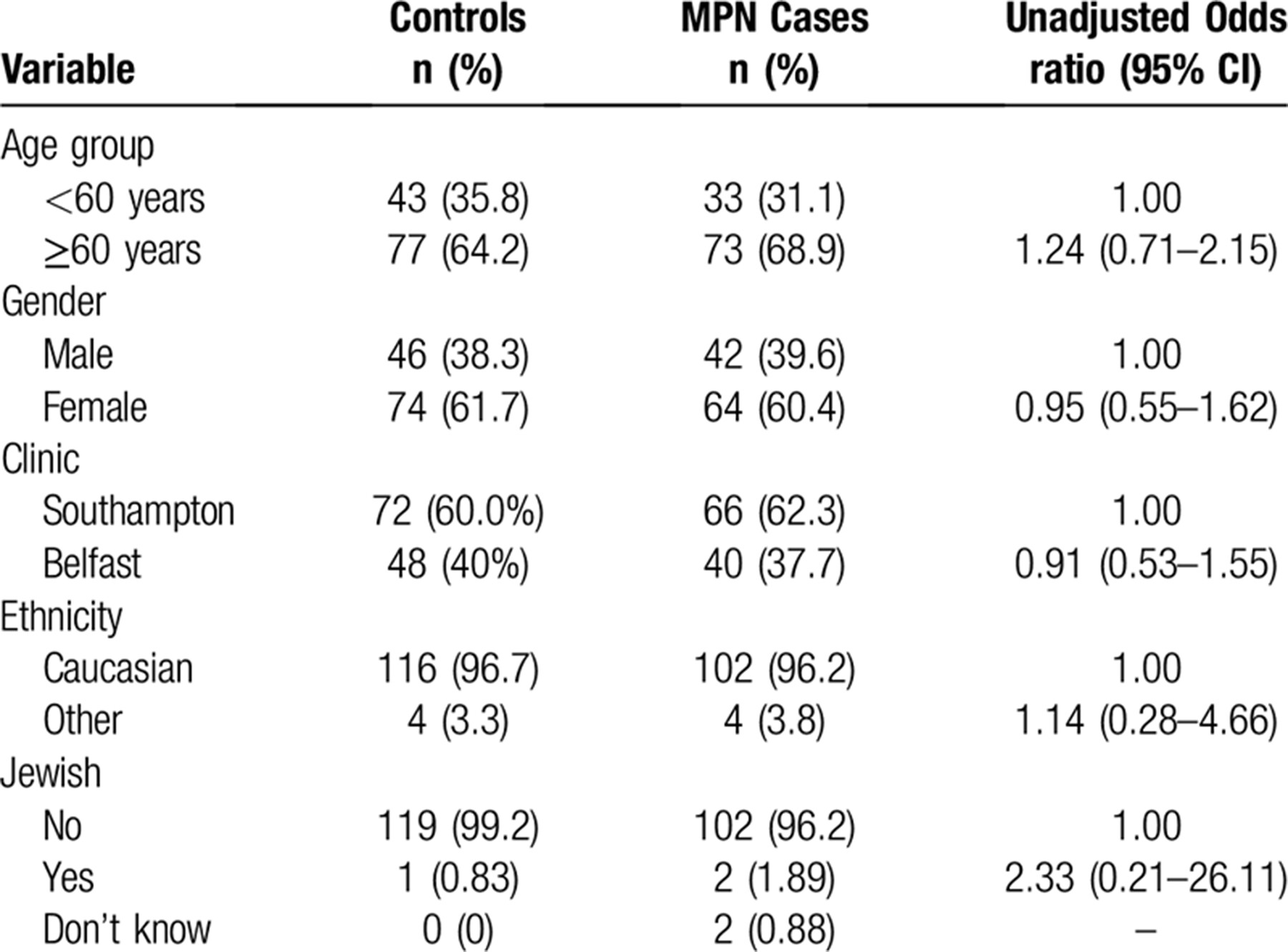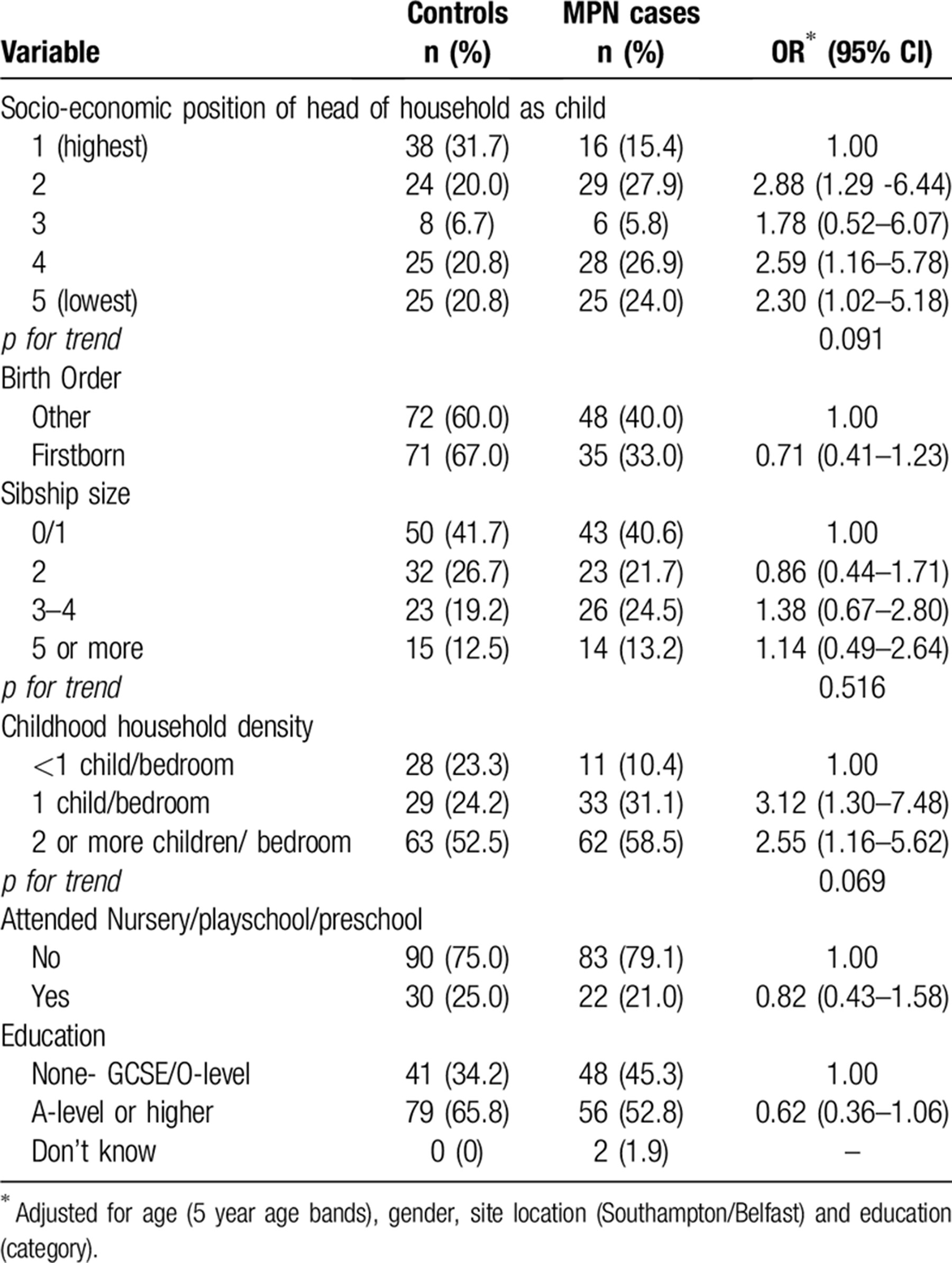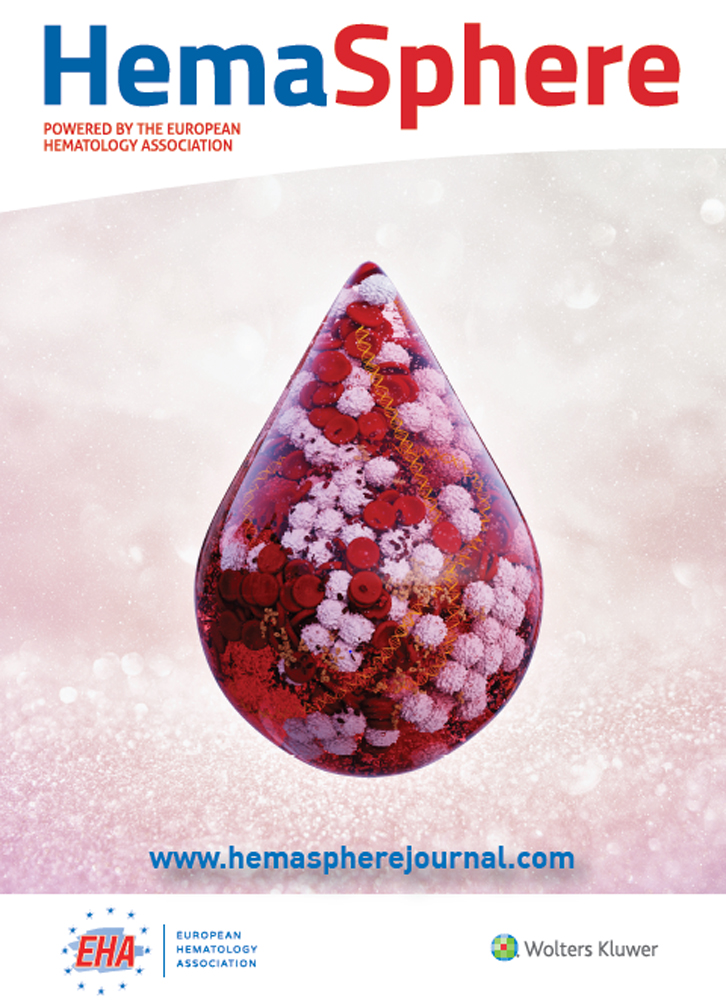Modifiable Lifestyle and Medical Risk Factors Associated With Myeloproliferative Neoplasms
Ethical approval was obtained from the Office for Research Ethics Committee, Northern Ireland (ORECNI 12/NI/0165). All participants provided written informed consent. The study was performed in accordance with the Declaration of Helsinki.
This work was supported by MPN Voice (grant number 0001); GJ was a PhD candidate at Queen's University Belfast supported by funding from MPN Voice; LF is supported by fellowships from the National Health and Medical Research Council and Cancer Council Western Australia.
The authors have no conflicts of interest to disclose.
Abstract
Despite the identification of acquired genetic mutations associated with Myeloproliferative Neoplasms (MPNs) there is a paucity of information relating to modifiable risk factors that may lead to these mutations. The MOSAICC Study was an exploratory case-control study of polycythemia vera (PV), essential thrombocythemia (ET), and Myelofibrosis (MF). MPN patients and population controls (identified by General Practitioners) and non-blood relative/friend controls were recruited from 2 large UK centers. Participants completed a telephone-based questionnaire analyzed by unconditional logistic regression analysis adjusting for potential confounders. Risk factors for MPNs identified included increasing childhood household density [odds ratio (OR) 2.55, 95% confidence interval (CI) 1.16–5.62], low childhood socioeconomic status (OR 2.30, 95%CI 1.02–5.18) and high pack years smoking (OR 2.19, 95%CI 1.03–4.66) and current smoking restricted to JAK2 positive PV cases (OR 3.73, 95%CI 1.06–13.15). Obesity was linked with ET (OR 2.59, 95%CI 1.02–6.58) confirming results in previous cohort studies. Receipt of multiple CT scans was associated with a strongly increased risk of MPN although with wide confidence intervals (OR 5.38, 95%CI 1.67–17.3). Alcohol intake was inversely associated with risk of PV (OR 0.41, 95%CI 0.19–0.92) and ET (OR 0.48, 95%CI 0.24–0.98). The associations with childhood household density, high pack years smoking and alcohol were also seen in multivariate analysis. This is the largest case control study in MPNs to date and confirms the previously reported associations with obesity and cigarette smoking from cohort studies in addition to novel associations. In particular, the role of smoking and JAK2 mutation cases merits further evaluation.
Introduction
Myeloproliferative neoplasms (MPNs) are a group of rare hematopoietic malignancies characterized by stem cell-derived clonal proliferation of myeloid lineages. Reported incidence rates vary with our recent systematic review reporting pooled incidence rates for polycythemia vera (PV), essential thrombocythemia (ET) and primary myelofibrosis (PMF) of 0.84, 1.03 and 0.47 per 100,000, respectively.1 In these Ph-negative MPN cases, referred to as classic MPNs, an acquired genetic mutation of Janus kinase 2 (JAK2)v617F is present in almost all PV patients and approximately 50% ET and PMF patients.2 Other acquired mutations, including myeloproliferative leukemia virus oncogene codon 515 (MPL)3 and Calreticulin (CALR) 4, 5 have been identified. Inherited defects in DNA repair increase the risk of hematopoietic neoplasms.6-8 DNA repair genes, for example, XRCC1 and other genes shown to be environmentally sensitive (NAT2, CYP1A2, GSTA1, and GSTM3) have been associated with MPN,9 suggesting that environmental carcinogens may be involved in their development and the acquisition of acquired mutations.
Our research group lead a systematic review which identified limited etiological studies for the classic MPNs.10 Seven case-control studies with sample sizes ranging from 9 to 93 MPN patients11-17 were identified. Potential risk factors identified included dark hair dye use, blood donation and a variety of occupational exposures.10 These studies were severely limited by small sample sizes and/or inability to investigate subtype specific risks.11, 13 While smoking and alcohol were not associated with MPNs in these small case control studies,13, 17 current smoking, increasing body mass index (BMI), and lower physical activity levels were positively associated with some MPN subtypes in recent cohort studies.18-20 To investigate potential risk factors further we undertook an exploratory case-control study in the United Kingdom (UK).
Methods
The exploratory MOSAICC (Myeloproliferative Neoplasms: An In-depth Case-Control) study aimed to identify appropriate methodological approaches to roll-out a large UK-wide case-control study of MPNs. MPN patients were recruited from 2 sites: Belfast City Hospital, Belfast and University Hospital Southampton NHS Foundation Trust, Southampton. Eligible patients, identified by their lead consultant (MFMcM and ASD), were classified according to the WHO diagnostic criteria.21 A study information pack was provided containing a consent form, study information booklet and a MPN-Symptom Assessment Form.22 Patients were asked to recruit non-blood relative or friend (NBR/F) controls to the study by providing them with information flyers. Age (5-year age band) and gender frequency-matched General Practice (GP) controls were also recruited. Patients were ineligible if they were < 18 years of age or were incapable of giving informed consent or were physically or cognitively incapable of completing a telephone interview. Participants underwent a structured telephone interview (average interview time: 45 minutes) with a trained interviewer using a questionnaire designed to identify medical and lifestyle risk factors. Ethical approval was obtained from the Office for Research Ethics Committee, Northern Ireland (ORECNI 12/NI/0165).
Data was collected on gender, age (dichotomized to < 60 and ≥60 years), recruiting clinic (Belfast/Southampton), ethnicity (Caucasian vs other) and Jewish ancestry. Childhood socio-economic position (SEP), based on main household occupation, was classified using the Standard Occupational Classification system from highest1 to lowest5 social class.23 Birth order and number of siblings (termed sibship size) were requested with childhood household density calculated by dividing the number of children by the number of bedrooms in the childhood home. Level of education was categorized as none- GCSE/O-level or A-level or higher or equivalents. Pack years of smoking was calculated by dividing average number of cigarettes smoked/day by 20 and multiplying by years of smoking. Alcohol consumption was measured by the average number of units of wine, beer or spirits consumed per week within or above the UK Drinkaware guidelines.24 Self-reported weight and height were used to calculate BMI with classification according to the World Health Organization criteria (underweight: < 18.5 kg/m2, normal weight: 18.5–24.99 kg/m2, overweight: 25–29.99 kg/m2, obese/severely obese: ≥30 kg/m2).25 Questions included self-reported piercings, tattoos, tooth fillings, implants (metal plates, silicone implants etc.) and hair dye use. Current information on use and storage of chemicals within the home in addition to hobbies and air travel was also obtained. Additionally, a range of pre-existing medical conditions identified in the systematic review10 was investigated.
Statistical analysis
Variables were compared between GP and NBR/F controls using unconditional logistic regression. Multivariate logistic regression models comparing MPN patients to all controls were adjusted for age, gender and clinic (location) producing adjusted odds ratios (ORs) and corresponding 95% confidence intervals (CIs). Tests for trend were used to determine significance per category increase of the exposure/variable. A backwards stepwise logistic regression analysis was constructed including associations significant at p < 0.010 to identify key risk factors. Statistical analyses were performed using STATA 12.0™ (StataCorp, College Station, TX).
Results
In total, 106 MPN cases and 120 controls were included in these analyses representing overall participation rates of 66.7% and 32.3%, respectively. Rates were much lower in GP vs NBR/F controls; 17.0% and 72.5%, respectively. After adjustment for age, gender, clinic and education, GP controls were less likely to be female (p = 0.009), to have tooth fillings (p = 0.001) and more likely to have asthma (p = 0.045) than NBR/F controls. The control groups did not differ in regard to any of the other exposures assessed and we therefore combined the 2 groups for analysis.
Mean age did not significantly differ between cases [63.3 years, standard deviation (SD) 12.5 years] and controls (60.5 years, SD 12.4 years), p = 0.093. Compared to all controls MPN cases did not significantly differ with regard to any of the participant characteristics reported in Table 1. The distribution of patients within the 3 subtypes of MPN is shown in Table 2. Of the MPN cases 71 (67.0%) were JAK2 positive.
Childhood factors
MPN patients were more likely than controls (all or either subgroup) to have been raised in a household where the main occupation was of a lower socio-economic status, (OR 2.30, 95%CI 1.02–5.18). There was trend for MPN patients to have experienced higher childhood household density than controls (OR 2.55, 95% CI 1.16–5.62), although this trend did not reach significance, Table 3.
Lifestyle factors
Current cigarette smoking was more common in cases than controls but statistical significance was only observed in those who had the highest pack years of smoking, (OR 2.19 95%CI 1.03–4.66, p = 0.01; Table 4. Current smoking status was significantly elevated for PV cases only (OR 3.73, 95% CI 1.06–13.15) Table 5.
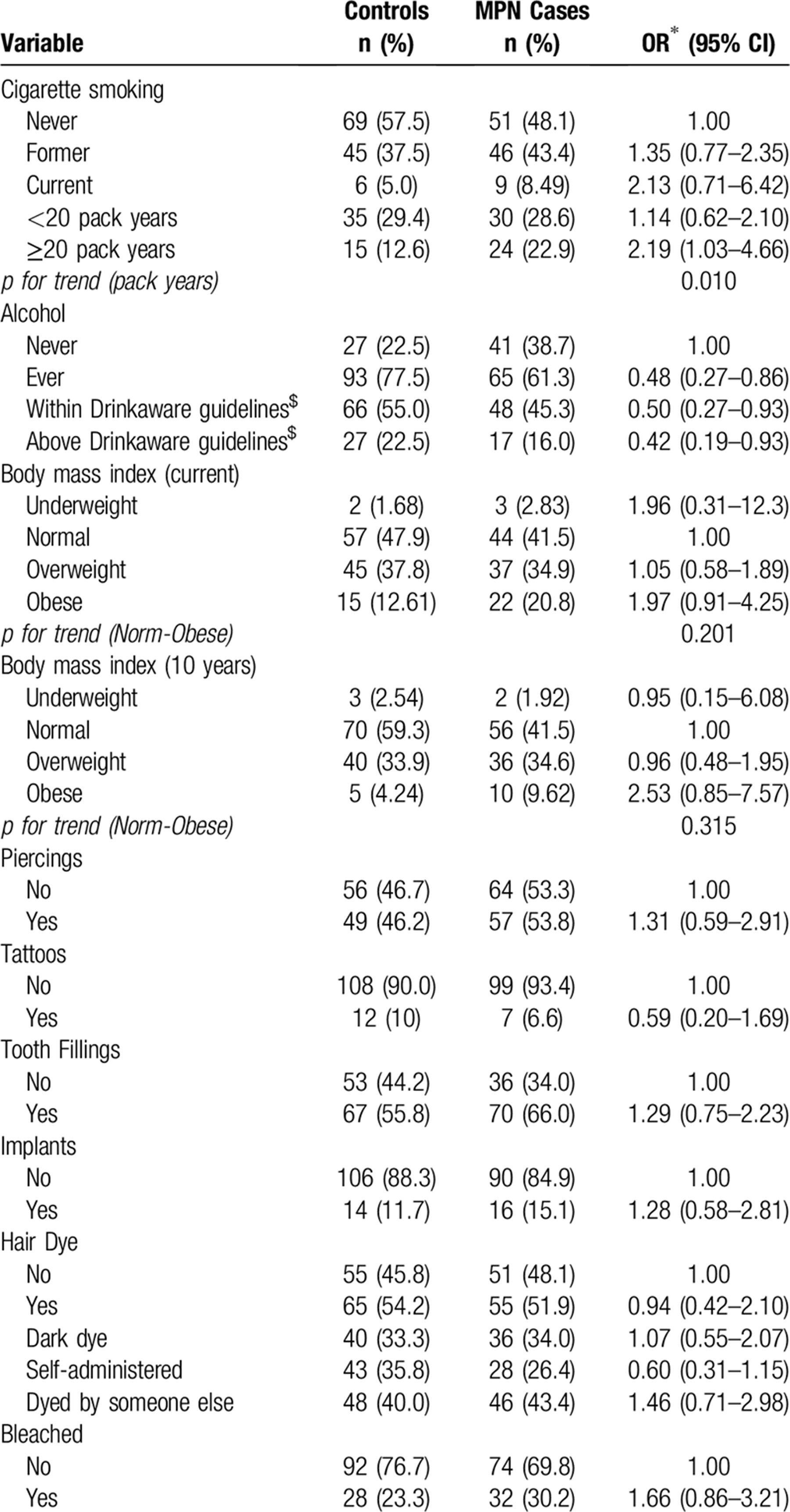

Alcohol consumption was inversely associated with MPNs, in PV (OR 0.41, 95% CI 0.19–0.92) and ET (OR 0.48, 95% CI 0.24–0.98) but not MF (OR 1.03, 95% CI 0.26–4.11). Risk of MPNs did not significantly differ by alcohol type consumed; wine (OR 0.90, 95% CI 0.49–1.64), beer (OR 0.81, 95% CI 0.30–2.17) and spirits (OR 0.41, 95% CI 0.08–2.21) Tables 4 and 5.
While obesity appeared to elevate overall MPN risk it was not significant, Table 4. However, when stratified by MPN subtype, obesity was significantly associated with ET (OR 2.59, 95% CI 1.02–6.58) only, Table 5. There were no significant associations between piercings, tattoos, implants or hair dying and MPNs, Table 4.
Environmental factors/other
There were no significant associations between use of potential household carcinogens and excess MPN risk. Painting in home decorating was less commonly reported among MPN patients than controls, (OR 0.44, 95%CI 0.25–0.79) Table 6. The majority (>90%) of participants had had pets but there was no significant difference overall between cases and controls (OR 0.90, 95% CI 0.37–2.17). Of all animal types investigated only pig ownership was higher among cases than controls, 8 (7.5%) vs 2 (1.7%) (OR 5.62, 95% CI 1.13–28.0). Low absolute numbers precluded further multivariate analysis and larger studies will be needed to determine whether this is a genuine risk factor.
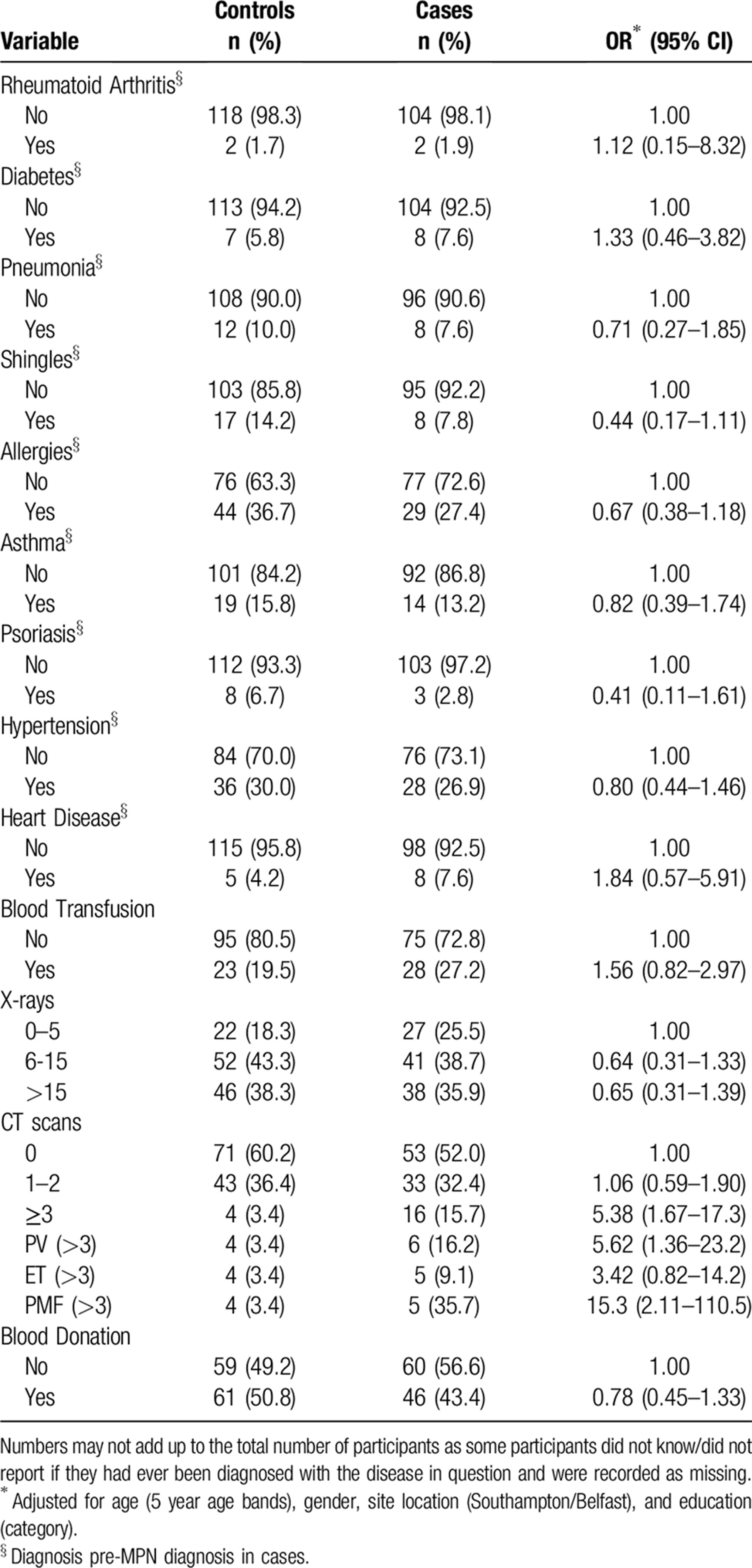
There were no significant associations seen with a number of other putative environmental risk factors including the use of home solvents, paints, bleach, oven cleaner, garden herbicides or pesticides, frequency of boiler maintenance or home car mechanical work. Also, no differences between cases and controls were seen in the frequency of short or long haul flights taken per year.
Medical history
There were no significant associations between any of the medical conditions (diagnosed before MPN diagnosis) and MPNs, Table 6. Of the medical procedures investigated only the frequency of CT scans was associated with an increased risk of MPNs, Table 6. Patients receiving 3 or more CT scans had OR of 5.38 (95%CI 1.67–17.3). There was no difference between cases and controls by any CT sites (data not shown) or by the proportion of cases having had a CT scan by clinic. MPN patients and controls reported having had CT scans of their full body (n = 9 cases vs 9 controls), head and neck (n = 15 vs 12), back (n = 2 vs 3), chest (n = 9 vs 4), abdomen (n = 18 vs 17), groin (n = 3 vs 0) and legs/arms (n = 6 vs 6).
Multivariate model
In the backwards multivariate regression model, smoking >20 pack years, (OR 2.69, 95% CI 1.26–5.74) and childhood household density (Intermediate vs low: OR 2.35, 95% CI 1.01–5.45); high vs low: OR 2.34, 95% CI 1.26–5.74) remained significantly associated with increased risk of MPNs. Alcohol (OR 0.50, 95% CI 0.27–0.94) and household painting (OR 0.42, 95% CI 0.23–0.76) remained inversely associated with MPNs.
Discussion
In this exploratory case-control study, we confirmed associations between MPNs and smoking and obesity (for ET patients only) and identified other potential risk factors including childhood household crowding and receipt of multiple CT scans.
Childhood circumstances may influence chronic diseases in later life. Lower childhood SEP has been associated with increased cancer mortality rates for smoking-related cancers in some studies potentially mediated in part by lifestyle choices and SEP in later life.26 When adjusted for potential confounding factors, including years of formal education, we identified that lower childhood SEP was associated with an increased risk of MPNs potentially mediated via similar mechanisms. Indeed, when we ran a multivariate model with backwards selection of significant exposure variables, childhood household density remained significantly associated with MPNs. There was also a borderline association between higher educational attainment and reduced risk of MPNs which could point towards occupational exposures or lifestyle risk behaviors.
In keeping with the recent Million Women Study18, 19 and Iowa Women's Health Study20 smoking 20 or more pack years of cigarettes was associated with an increased risk of MPN in our study. Supporting the findings from The Iowa Women's Health Study we identified that the association with current smoking was limited to patients with PV.20 As the previous study used medical claims data, misclassification of cases presenting with secondary or apparent polycythemia as a result of smoking, may have occurred.27 In contrast, we had a defined case identification process ensuring only primary PV patients were included in the study and confirmed the association was limited to PV cases. Studies have demonstrated a link between current smoking status and increased JAK2v617F mutations, potentially through activation of the JAK pathway via inflammatory processes.28-30 Given that the majority of PV patients had JAK2v617F mutation present (94.6%), while only 56.4% and 35.7% of ET and PMF patients were JAK2v617F positive; this could explain the observed differences by MPN subgroup. We were unable to confirm this due to limited power but the ORs were higher compared to controls for JAK2 positive (OR 2.58) than for JAK2 negative (OR 1.70) cases.
Two cohorts also investigated the association between BMI and MPNs. In the Million Women Study, obese women had a 33% increased risk of MPNs.19 While we did not observe an overall statistically significant association we observed a similar increase in obese individuals. In keeping with our findings, the Iowa Women's Study reported that increasing BMI was associated with a significantly increased risk of ET but not PV.20 They also reported an increased risk of ET among diabetics although we did not replicate this in the current study. It has been speculated that similar pathways may link obesity and thrombocytosis. In mice studies deletion of Signal transducer and activator of transcription (STAT)3 in the central nervous system leads to obesity and diabetes in homozygous mutants31 and deletion of STAT3 in hematopoietic cells enhances thrombocytosis in JAK2v617F mouse models.32 The exact mechanism of action however requires further investigation.
Alcohol was inversely associated with MPNs in this study but has not previously been associated with MPNs.17-19 Alcohol consumption has, however, been inversely associated with other hematological neoplasms including lymphoma33, 34 and leukaemia.34 We asked about lifetime alcohol consumption and MPN patients may have altered their alcohol consumption post-diagnosis resulting in potential recall bias. While the risk reduction may be due to reverse causality, resveratrol, found in red wine, may reduce the risk of lymphoma35 and has been shown to inhibit proliferation and induce apoptosis in malignant cell lines with JAK2V617F mutation.36 We did not observe any significant differences in MPN risk by alcohol type (wine, beer, spirits) consumed but sample size was limited. Further evaluation of the potential interaction between alcohol and the JAK pathway is warranted.
Painting in decorating at home was inversely associated with MPNs. While multiple testing could explain this as a chance association, MPN patients may be less likely to paint due to the fatigue that they experience from their MPN. While reverse causation cannot be ruled out we asked whether the patients had ever painted with the association remaining in the multivariate model. The strong positive association between pig ownership and MPNs has not previously been reported. While it is likely a chance association due to multiple testing, further clarifications of the association in a larger, suitably powered, study is merited.
Exposure to radiation from CT scans has been reported to increase the risk of developing a number of cancers including leukaemia.37 We found that compared with controls, MPN patients were more likely to have received three or more CT scans, particularly those with PV. The elevated ORs in our study may have resulted in part due to the use of CT scans during the diagnostic work-up or evaluation of MPN patients. However, CT scans are generally not used for PV or ET diagnosis. Further evaluation of the case clinical notes was not available for validation and timing of CT scans so we cannot confirm whether or not all CT scans were pre-diagnosis. If there is a causal relationship, then the recent introduction of lower dose CT is likely to reduce the potential carcinogenic effects. Optimization of the CT image at lower doses and limiting CT scans on the basis of clinical need is important to reduce potential harmful effects.
Other potential risk factors identified in our previous systematic review of MPNs included blood donation, dark hair dye use and some autoimmune conditions.10 Although previous studies suggested higher PV risk among blood donors,38, 39 this was not substantiated in a recent cohort of 1.4 million blood donors40 in keeping with the results of the current study. We also found no association between dark hair dye use and MPNs or with any of the autoimmune conditions evaluated.
Given the rarity of MPNs, this is the largest case-control study to date. We evaluated 2 control groups, GP and NBR/F controls, and found little difference between groups for most variables assessed. NBR/F controls were more convenient and less expensive to recruit and are useful for rare diseases where patients are referred to secondary or tertiary care.41 While it is acknowledged that there are limitations with this method as it may lead to closer matching of the case and control populations, similar characteristics would actually attenuate observed associations rather than create erroneous associations.42 Even with modest numbers, our exploratory study demonstrated significant differences in several parameters under investigation between cases and NBR/F controls despite the likelihood of shared factors. However, our study is likely underpowered to detect small differences in MPN risk and a large co-ordinated study to evaluate risk factors associated with MPNs, to enable stratification by subtype, is warranted.
In conclusion, this exploratory case-control study confirms a reported association between cigarette smoking and PV. We also identified an increased risk of ET in patients defined as obese according to the WHO classification system. Further investigation of the relationship between CT scans and alcohol consumption with MPNs may help in the identification of the causal pathways that lead to acquisition of acquired mutations such as JAK2 in patients with MPNs. While this exploratory study is the largest case-control study of MPNs reported to date in the worldwide literature, replication in a larger case-control study is required to confirm or refute our findings.
Acknowledgements
We thank all the participants who contributed to the study. The work was supported by Queen's University Belfast's Centre for Public Health. The MOSAICC Study team acknowledges the support of the National Institute for Health Research, through the Northern Ireland Cancer Research Network (NICRN) and for Southampton, the Wessex Cancer Research Network. The MOSAICC Study team also acknowledges the support of research nurses Emma Gaunt of Southampton and Claire Leathem of Belfast. The interpretation and reporting of these data are the sole responsibility of the authors.



